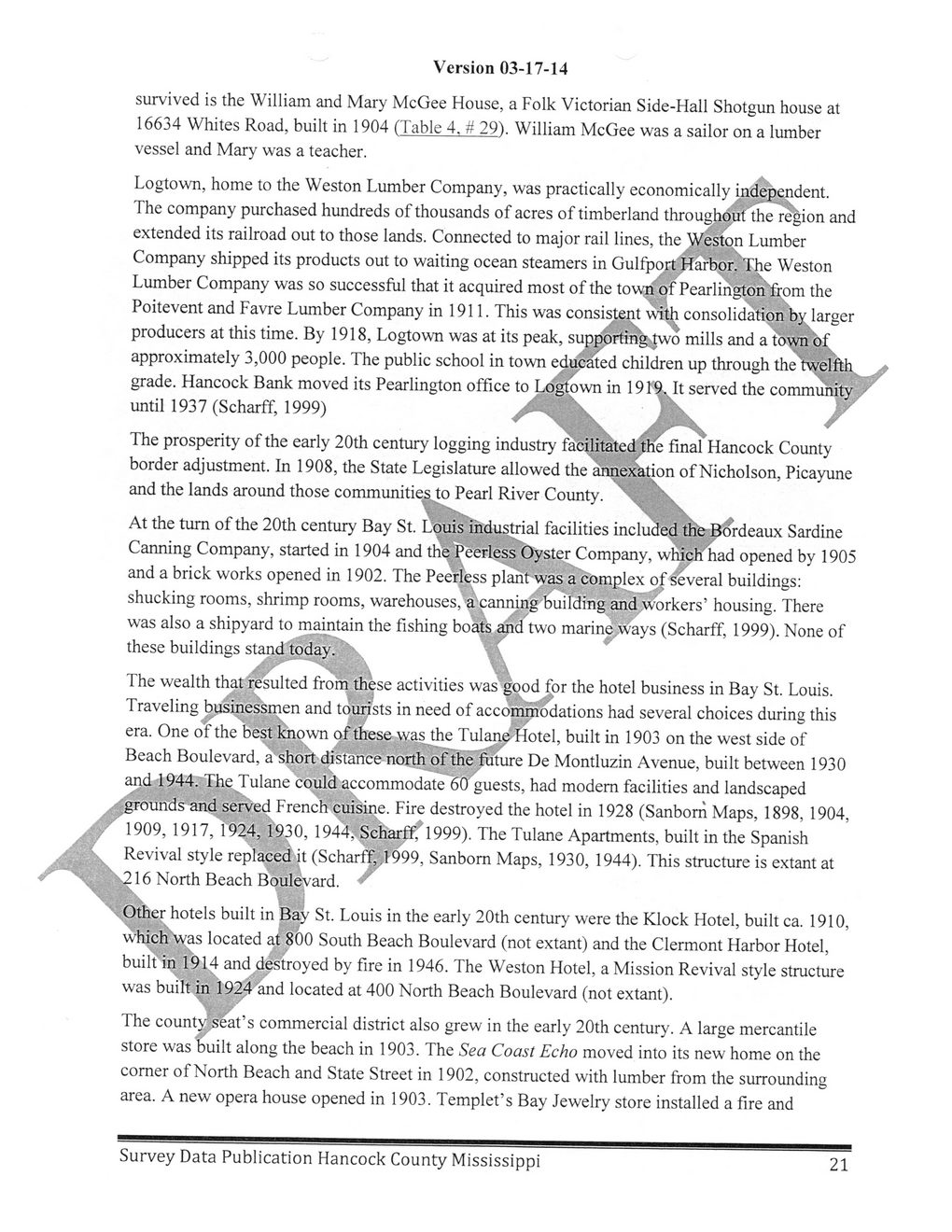This text was obtained via automated optical character recognition.
It has not been edited and may therefore contain several errors.
Version 03-17-14 survived is the William and Mary McGee House, a Folk Victorian Side-Hall Shotgun house at 16634 Whites Road, built in 1904 (Table_4J_#29). William McGee was a sailor on a lumber vessel and Mary was a teacher. Logtown, home to the Weston Lumber Company, was practically economically independent. The company purchased hundreds of thousands of acres of timberland throughout the region and extended its railroad out to those lands. Connected to major rail lines, the Weston Lumber Company shipped its products out to waiting ocean steamers in Gulfport Harbor. The Weston Lumber Company was so successful that it acquired most of the town of Pearlington'from the Poitevent and Favre Lumber Company in 1911. This was consistent with consolidation by larger producers at this time. By 1918, Logtown was at its peak, supporting two mills and a town of approximately 3,000 people. The public school in town educated children up through the twelfth grade. Hancock Bank moved its Pearlington office to Logtown in 1919. It served the community until 1937 (Scharff, 1999) \ j\ \ \ . /•'" X> The prosperity of the early 20th century logging industry facilitated the final Hancock County border adjustment. In 1908, the State Legislature allowed the annexation of Nicholson, Picayune and the lands around those communities to Pearl River County. \ \ w \ \ .> At the turn of the 20th century Bay St. Louis industrial facilities included the Bordeaux Sardine Canning Company, started in 1904 and the "Peerless Oyster Company, which’had opened by 1905 and a brick works opened in 1902. The Peerless plant was a complex of several buildings: shucking rooms, shrimp rooms, warehouses, a canning building and workers’ housing. There was also a shipyard to maintain the fishing boats and two marine ways (Scharff, 1999). None of these buildings stand today. ' • The wealth that resulted from these activities was good for the hotel business in Bay St. Louis. Traveling businessmen and tourists in need of accommodations had several choices during this era. One of the best known of these was the Tulane Hotel, built in 1903 on the west side of Beach Boulevard, a'short distance north of the fiiture De Montluzin Avenue, built between 1930 and 1944. The Tulane could accommodate 60 guests, had modem facilities and landscaped grounds and served French cuis'ine. Fire destroyed the hotel in 1928 (Sanborn Maps, 1898, 1904, 1909, 1917, 1924, 1930, 1944, Scharff, 1999). The Tulane Apartments, built in the Spanish Revival style replaced it (Scharff, ,1999, Sanborn Maps, 1930, 1944). This structure is extant at 216 North Beach Boulevard. Other hotels built in Bay St. Louis in the early 20th century were the Klock Hotel, built ca. 1910, which was located at 800 South Beach Boulevard (not extant) and the Clermont Harbor Hotel, built'in 1914 and destroyed by fire in 1946. The Weston Hotel, a Mission Revival style structure was built in 1924'and located at 400 North Beach Boulevard (not extant). The county seat’s commercial district also grew in the early 20th century. A large mercantile store was built along the beach in 1903. The Sea Coast Echo moved into its new home on the comer of North Beach and State Street in 1902, constructed with lumber from the surrounding area. A new opera house opened in 1903. Templet’s Bay Jewelry store installed a fire and Survey Data Publication Hancock County Mississippi 21

Hancock County History and Archeology Survey-Publication-Data-2014-(22)